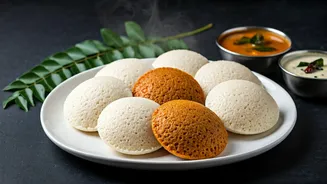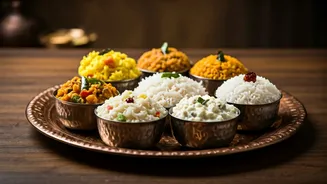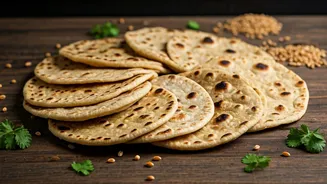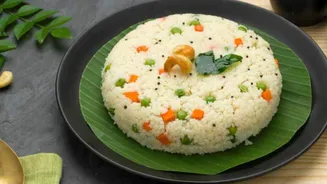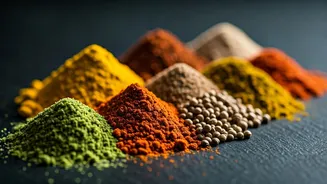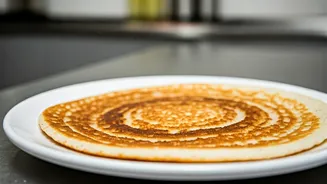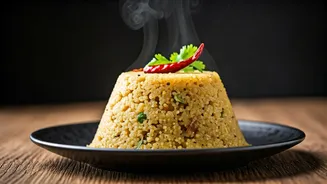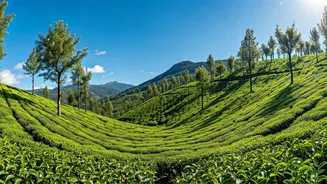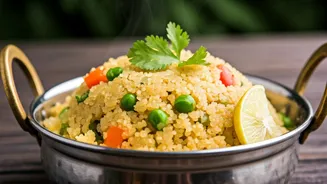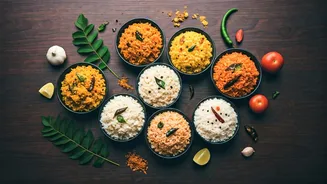The Classic: Plain Idli
Plain idli, the quintessential South Indian breakfast dish, is made with fermented batter of rice and urad dal. Its simplicity is its strength; it's a blank
canvas for a variety of accompaniments like sambar and chutney. The fermentation process is key, as it not only lends the idli its characteristic fluffiness but also aids in digestion. The ideal plain idli should be soft, spongy, and slightly sour, reflecting a well-fermented batter. Traditionally steamed in special idli molds, they are a light yet filling start to the day. This classic remains popular across South India, a testament to its enduring appeal and balanced nutritional profile.
Thatte Idli: Plate-sized Delight
Thatte idli, literally 'plate idli,' is a unique variation known for its size and thickness. It's cooked on a plate, resulting in a larger, flatter idli compared to the regular ones. The batter is similar to plain idli, but the cooking method and portion size distinguish it. Its texture is typically denser and softer due to the cooking style. Often served with a generous helping of butter or ghee, thatte idli is a fulfilling option, especially popular in Karnataka. Its size and the way it is served provide a satisfying eating experience, making it a favorite for those seeking a heartier breakfast option.
Rava Idli: Semolina Infusion
Rava idli offers a unique twist by incorporating semolina (rava) into the batter, alongside rice. This substitution changes the texture and flavor, yielding a slightly coarser and less spongy result. It's a quick and relatively easy option, often requiring less fermentation time than traditional idli. Common additions include tempering with mustard seeds, curry leaves, and other spices, adding complexity to the taste. Rava idli is a popular choice for those wanting a lighter, less time-consuming breakfast that still captures the essence of South Indian cuisine. Its preparation varies across regions, and it is frequently served with coconut chutney and sambar.
Kanchipuram Idli: Aromatic Special
Kanchipuram idli is a flavorful variation originating from the temple town of Kanchipuram in Tamil Nadu. What sets it apart is the addition of spices like cumin, ginger, and asafoetida, along with tempering of mustard seeds and curry leaves. The batter is prepared in the standard manner, but these additions infuse the idli with an aromatic and zesty profile. This idli has a unique preparation style, where the batter is often cooked in a cloth-lined steamer, giving it a distinctive shape. Traditionally, the idli is associated with temple offerings and is known for its distinct taste, making it more than just a breakfast item. It represents a delightful blend of taste and religious significance.
Mudde Idli: Millet Power
Mudde idli, also known as 'ragi idli,' incorporates ragi flour (finger millet) into the traditional idli batter. This addition brings a nutty flavor and added health benefits due to the high nutritional value of ragi. The texture tends to be denser and chewier compared to plain idli. Mudde idli is a popular choice for health-conscious individuals, as ragi is rich in fiber and minerals. It's often paired with sambar and chutney, and sometimes, a dollop of ghee. The inclusion of ragi provides a unique taste and is a healthy alternative to traditional options, offering a satisfying and nutritious breakfast.
Mini Idli: Cute & Convenient
Mini idli is a smaller version of the classic, perfectly bite-sized. Their petite size makes them ideal for children and allows for multiple servings. The batter is the same as plain idli, but the smaller molds result in quick cooking times and an appealing presentation. Mini idli is often served in a bowl of sambar or with a variety of chutneys, making them easy to eat. This presentation encourages exploration of various flavors and textures. Their small size makes them incredibly versatile, suitable for both breakfast and as a snack.
Sanna: Goan Steamed Idli
Sanna, a steamed idli variant from Goa, is made with a combination of rice and urad dal, often including the addition of toddy or yeast for fermentation. This gives the idli a distinct sweetness and fluffy texture. It may also include the addition of coconut milk or grated coconut. Sanna is typically paired with Goan curries, and the slight sweetness complements spicy dishes beautifully. The unique fermentation process contributes to its light, airy texture and distinctive flavor profile. This idli variation is more than just a breakfast dish, as it is a cultural symbol, reflecting the region's culinary heritage and distinct taste preferences.
